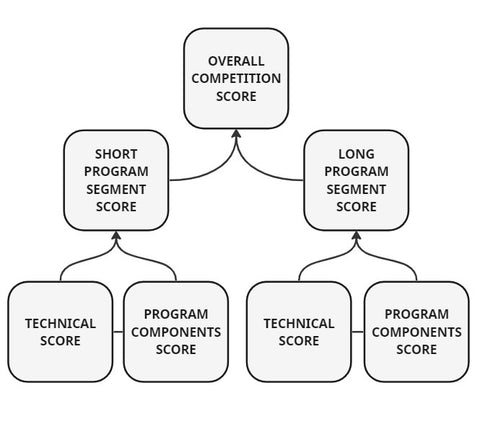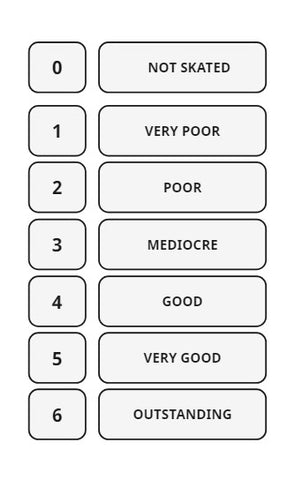If you're keen to understand how scoring in figure skating works, you've come to the right place. In this guide we’re going to explore how figure skating scoring has changed over time, what scoring system is used today and answer common FAQs on figure skating rules. Get ready to learn how judges assess and score skaters' performances on the ice.
The Evolution of Figure Skating Scoring Systems
Figure skating scoring has evolved greatly during the course of the sport, transitioning from the subjective 6.0 system to the more analytical International Judging System (IJS).
In the earlier 6.0 system, skaters received marks primarily on technical skills and artistic impression. However to enhance fairness and detail in scoring, the IJS was introduced. Also known as the “Code of Points” system, the IJS offers a granular breakdown of each skating element. Skaters are now judged on everything they do on the ice, from their jumps to how they present themselves.
This change marks a significant step towards more objective and comprehensive scoring in figure skating, making it a fairer way to see who stands out.
The International Judging System (IJS)
The International Judging System (IJS) is the go-to method for scoring in figure skating, used in competitions worldwide, from the Olympics to local events. In this system, skaters earn points for each move, split into two main scores: the technical elements score (TES) and the program components score (PCS). This way, every spin, leap, and glide has a clear impact on the final score, making competitions fair and exciting to follow.
In the International Judging System, there are two main groups of people involved in the scoring process:
- The Technical Panel - this panel is composed of 3 experts: a Technical Controller, a Technical Specialist, and an Assistant Technical Specialist. They make sure each skating move is identified correctly and given a base value. Their job is to watch closely and judge the technical parts of the performance.
- The Judges - there are usually 9 judges in major competitions, who assess how well skaters perform and how artistic their routine is. The judges score the skaters based on how they execute their moves and how good their performance looks overall, focusing on the skater's skills and how they present themselves on the ice.
How does the IJS scoring system work?
The IJS scoring system consists of two main scores - the Technical Score and the Program Components Score. These scores combine to form a “Segment Score” for both the short and long program. Segment scores are then combined to provide the overall competition score.
It sounds a little complicated! To make it easier, try visualising the IJS Scoring system as a pyramid shape:

At the bottom tier of the pyramid you will have the skater’s technical score and program components score for each segment. On the middle tier, you’ll have the skater’s segment score for the long and short program. And on the top tier, you’ll have the overall competition score.
IJS Technical Score
The IJS technical score, or element score, is the sum of points a skater earns for each technical element they perform. For example jumps, spins, and footwork.
Each element has a base value, and skaters can earn more points based on how well they execute them. The Grade of Execution (GOE) comes into play here, where judges add or subtract points from the base value depending on the quality of the execution.
A skater's technical precision can significantly boost their technical score, making every element crucial to their overall performance.
IJS Program Components Score
The IJS program components score assesses the artistic aspects of a skater's performance, evaluating how well they present their routine beyond just the technical elements. Skaters earn points based on five criteria: Skating Skills, Transitions, Performance, Composition, and Music Interpretation.
- Skating Skills - the quality of skating speed, stability and edge control.
- Transitions - the intricacy and variety of movements between elements.
- Performance - the skater's ability to connect with the audience and convey emotion.
- Composition - the structure of the skating routine and how elements are integrated.
- Music Interpretation - how well the skater's movements reflect and enhance the music.
IJS Segment Score
The IJS segment score is the sum of the technical score (element score) and the program components score within a single segment of a competition, such as the short program or free skate. To calculate a skater's overall competition score, these segment scores from different parts of the competition are added together.
For example:
Short Program Segment Score + Free Skate Segment Score = Overall Competition Score
This cumulative score determines the skater's final ranking in the competition.
The 6.0 Judging System
The 6.0 judging system was the standard figure skating scoring system until 2004. It used a simpler scale ranging from 0.0 to 6.0, with judges scoring skaters based on technical merit and artistic impression. The 6.0 Judging system was last used competitively in the U.S. at the 2004 National Championships. Today this system is sometimes used in local competitions or ice shows, it acts as a more simplified scoring system that audiences can more easily understand and engage with.Unlike the IJS system, where performance is evaluated by both judges and a technical panel, the 6.0 system judges have a more generalist role. Points are awarded based on the overall impression of a skater's technical and artistic performance, meaning scoring was often subjective and down to the discretion of the judges.
- The Judges - In the 6.0 system, typically, a panel of nine judges was used however this number could vary depending on the level of the competition.
How does the 6.0 judging system work?
In the 6.0 judging system, skaters were awarded two sets of marks by each judge: one for technical merit and another for artistic impression, with each mark ranging on scale from 0.0 to 6.0.

The judges would observe the skaters' performances, then assign these scores based on their overall assessment of the skaters' technical skills and presentation. The highest and lowest scores from the judges were often discarded, and the remaining scores were averaged to determine the skater's final score for that segment of the competition.
Score High with Chique Sport

At Chique Sport we're all about providing top-notch clothing for figure skaters, whether they're just starting out or competing at the pro level. We focus on making premium quality training gear that’s both comfortable and fashionable - when a skater looks their best and feels confident this definitely shines through in the overall skating performance.
Check out our full range of Figure Skating Clothing for Women, Men and Kids!





















